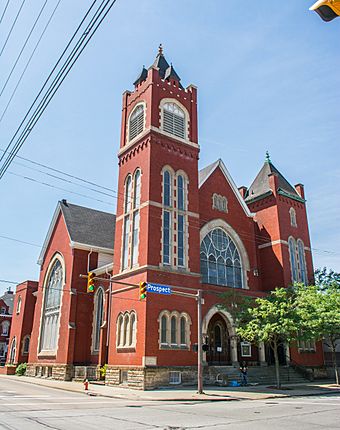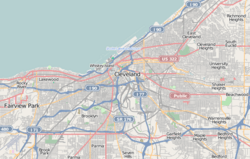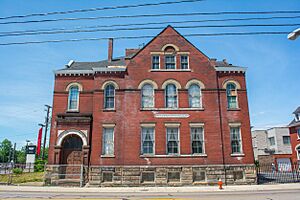Zion Lutheran Church (Cleveland, Ohio) facts for kids
Quick facts for kids |
|
|
Zion Lutheran Church
Zion Lutheran School |
|

Front and eastern side of the church
|
|
| Location | 2062 (church) and 2074 (school) E. 30th St., Cleveland, Ohio |
|---|---|
| Area | Less than 1 acre (0.40 ha) |
| Built | 1902 |
| Architect | Frank Walker (church); William H. Dunn (school) |
| Architectural style | Late Gothic Revival (church); Colonial Revival, Queen Anne (school) |
| MPS | Upper Prospect MRA |
| NRHP reference No. | 84000261 (church); 84000264 (school) |
| Added to NRHP | November 1, 1984 |
Zion Lutheran Church is a very old Lutheran church in Cleveland, Ohio. It is located near the city center on Prospect Avenue. The church was started in the 1840s. The current church building was built just after 1900. Next to it is a school building that belonged to the church. Both buildings are now considered important historic sites. The school building is not used for classes anymore.
Contents
History of Zion Lutheran Church
The area around Prospect Avenue where Zion Lutheran Church stands was mostly homes around 1860. It was one of the richer parts of Cleveland. This is why many grand churches, like Zion, were built there. Other famous churches nearby include First Methodist and Trinity Cathedral. This continued until about 1915. After that, the area slowly became more about businesses. By the 1930s, many old buildings were torn down. Often, this was to make space for parking lots.
Zion Lutheran Church was built in this changing neighborhood. Its construction finished in 1902. The church opened for people to use in 1903. The church congregation was started by German immigrants in 1843. It is the oldest Lutheran church group still active in Cleveland. Many other Lutheran churches in the Cleveland area, like Trinity Lutheran Church, grew from Zion.
The first church building was in downtown Cleveland. But by 1902, many German families lived on the east side. So, the church decided Prospect Avenue was a better spot. This would help them serve the community well.
The Church School
From its very early days, the church also had a school. Zion Lutheran School started in 1848. At that time, all the students were taught in German. The school moved to Prospect Avenue before the church did. The current school building was finished in 1903. This was two years after its main hall was completed and classes began there. William Dunn was the architect who designed the school. Frank Walker, from the company Walker and Weeks, designed the church.
Both the school and the church are made of brick. They have strong stone foundations and other stone details. The church is built in the Gothic Revival style. This style often looks like old European cathedrals. The school building mixes two styles: Queen Anne and Colonial Revival. The school stopped holding classes in 1974.
In 1984, both Zion Lutheran Church and its school were added to the National Register of Historic Places. This means they are important historical buildings. They were recognized for their special architecture. They also played a big part in the local history of Cleveland. They are also city historic landmarks. Their location is part of the city's Prospect Avenue Historic District. The church was one of the first members of the Lutheran Church–Missouri Synod (LCMS). It is still part of this group today.
First Christmas Tree in an American Church
One of the early pastors at Zion Lutheran Church was Heinrich Christian Schwan. He was also the third president of the LCMS. People often say he was the first pastor to put a Christmas tree in an American church. He and his wife put one up at Zion Lutheran in 1851. At that time, the church was located at Lakeside Avenue and East Sixth Street in Cleveland.
A special plaque has been placed at that spot. The Cleveland Landmarks Commission put it there to remember the event. However, some research shows there might have been an earlier instance. Reverend John Muehlhaeuser put up a tree in Rochester, New York, in 1840.
Images for kids







